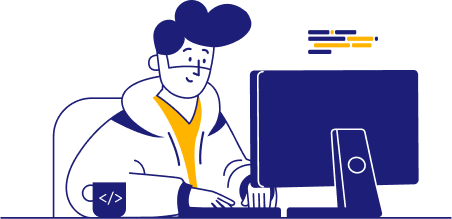Customer service is one of the most important positions within a company. A great customer service team can ensure customer loyalty, improve a company’s reputation, and accrue more followers and customers. Daily, they solve problems, foster goodwill, and communicate on the company’s behalf.
Customer service professionals are excellent critical thinkers who are flexible, analytical, and reliable. The top employees uphold company standards and treat every customer with kindness, respect, and an open mind. Companies with a high-performing customer service team create loyal customers and steady revenue.
Finding and building a stellar customer service team isn’t easy, but we can help. We give examples and advice for writing the best customer service job descriptions, so companies hire the right folks with the best job skills.
The Employer’s Guide to Writing a Customer Service Job Description

Most folks think of customer service cover letters and resumes as the first point of contact, but job descriptions are truly the first interaction between a business and its future employees. This means they should be personal, understandable, and detailed.
An excellent customer service job description explains who the company is, the problems they solve, the team who works there, and how their future customer service employee will help the company. It’s more than a list of requirements—it’s a true reflection of what the job looks like daily.
Showcase your company and its needs but not at the expense of the reader’s comprehension or interest.
So, a customer service job description should allude to the strengths of the customer service team and the company while highlighting how the future hire will assist the company. The description should be enticing and inspiring. Job seekers can read dozens of job descriptions, so organizations that go the extra mile with their job listings have a higher chance of finding their ideal employee.
Improving any kind of writing usually means making it more clear and concise, and the same is true for job descriptions. Customer service professionals know how to get to the heart of any issue, so your job description should do the same.
If the audience has to work to understand your meaning, they might lose interest altogether and stop reading. The article, “Simple rules for concise scientific writing,” argues that concise writing actually builds goodwill with the audience (Scott Hotaling). They get what they came for without confusion and feel satisfied.
Overall, when writing a customer service job description, keep it concise but informative, personal but professional, and strong but not pushy. You should showcase your company and its needs but not at the expense of the reader’s comprehension or interest.
How to Structure Your Customer Service Job Description

Here’s a reliable outline that covers all the bases for all customer service job descriptions.

Job details
This functions as the intro to the job. Who is your company, and what kind of customer service professional are they seeking? Why is it necessary or important that you add a customer service representative? This is an excellent place to include more of your company’s personality, but remember to keep it brief. Readers might not read this first, but this section gives them a taste of what’s to come.

About the company
This section is reserved for readers who are truly interested in applying. Here’s where you can give a brief summary of the company. Customer service professionals will need to know about the company’s mission and values to adequately advocate for the company, so this section should be more focused on the company’s goals rather than its history.

What you’ll be doing
The title of this section can also be called “Roles,” “Responsibilities,” or “Requirements.” This should be a list, preferably in bulleted form, of what the applicant will do if hired.
Many will assume some of their roles, including taking calls and engaging with customers but don’t shy away from the obvious. Your company does things differently from your competitors, so this section must be clear, specifying what even the “obvious” roles of a customer service professional will be. Use active verbs and specific wordage, and avoid jargon and filler.

Qualifications
Applicants should know what you require from them before they apply. Many customer service jobs require similar experience, so readers will likely skim this section. Ensure this section highlights the special qualifications your company requires while being understandable even at a glance.
Include education, experience, and specialization requirements. Personality words, including but not limited to “self-motivated,” “organized,” and “reliable” are also applicable, but don’t overuse them.

Benefits
You can include this section earlier if you wish, but the reader might want to know what they’ll be doing before you get to the benefits. However, most customer service jobs are similar in required roles, so adding this section earlier might help your company stand out from your competitors.
Writing a First-Rate Customer Service Job Description

Start with your goal—to hire the best employee for the customer service role. Does your company need to proactively provide outreach and anticipate problems customers might have? Does your company need to provide information and answer questions about your products? Describe briefly how this customer service hire will alleviate your company’s burdens.
The next step is to write the basics. As you write, keep it limited to the bare necessities. Start with a description. Who is your company, and what type of customer service role are they looking to hire? Then add the position’s duties. Also include the applicant’s required experience and employee benefits as listed in the outline above. Lastly, add a bit about your company.
As you write, keep in mind your audience. If you’re hiring an experienced customer service representative, using jargon is encouraged, but if the job is entry-level, using technical terms will turn away potential applicants. Use plain language, and keep it simple.
Once the facts of the job are set, the hard part begins—making it engaging. As we said, job applicants can read dozens, if not tens of dozens, of descriptions, so making yours stand out is crucial. It’s time to sell your company:
- Does your company culture include a good sense of humor? Add some funny quips or colloquial language.
- Does this job help the less fortunate? Highlight how your company benefits the community.
- Above all, ask yourself why someone would want to be part of your team, and let that inspire your job ad.
Emotive language and active verbs are great additions to your listing, but take care not to go overboard. Over-emphasis on the culture or company expectations can sound fake, or worse, overbearing. Subtle touches go a long way.
The penultimate step is easy and difficult all at once: cut all filler text. Filler text is anything that does not have relevance to the description. Don’t use three words when one will do. Use bullet points for lists. Make the description easy to read. If applicants have to scroll through chunks of text, they’ll move on or miss something important.
Also, look for anything that does not match the tone or message you’re intending. For example, a funny quote can keep people reading, but if it doesn’t have any relevance to the job, it will confuse readers instead of making them want to work with you.
Once the above is complete, take time away before you post. This ensures that when you proofread (which is the last step), you’ll be seeing all the potential mistakes and not glossing over them. It would be wise to have someone else give it one last look-over, too, though that’s not necessarily required.
The last step is proofreading. Look for any grammar or syntax errors or misspelled/misused words (affect vs. effect, for example). Then all that’s left is to post your job ad and wait for the customer service resumes to roll in.
What Customer Service Roles Does Your Company Need to Fulfill?

In customer service, the employee’s main goal is communication with customers, but that looks different across the board. Listed below are some examples of different roles to include in a customer service job description. One customer service hire might not complete all these roles, but it’s a good place to start.

Call center
Customers want quick solutions to problems, meaning calls are to be expected. Some customer service jobs rely only on telephones, while others include other avenues of communication. Regardless, customer service professionals should know how to handle high volumes of calls about various consumer issues.
- Answer client questions and quickly solve customer complaints via telephone, including customer account issues, return/refund policies, and product inquiries. Must also transfer calls to the correct department and record all calls in the company database.
- This role will require strong verbal communication and problem-solving skills focusing on clarity and empathy with the customer. Experience with KPIs a plus.

Technical assistance
One of the most common reasons a customer reaches out to a company is because of a technical problem. Customers may want a return or refund, their account might not be functioning, or they may not know how to use the company’s website. Customer service professionals must communicate solutions to technical problems quickly and kindly.
- Have a thorough working knowledge of computers and common technical issues. Must also be knowledgeable about the company’s website, account pages, and policies regarding returns, refunds, and customer accounts.
- This role will require strong technical competence, including but not limited to knowledge of computer programming, website maintenance, and keyword optimization.

Marketing
Sometimes customers don’t have complaints or technical issues, but they do have concerns about your company’s products. Customers like to know that they have an honest advocate who will tell them the good and the bad about what they seek.
Whether it’s picking between cleansers or finding the correct accelerator cable, a customer service professional should anticipate a customer’s needs and guide them to the proper solution.
- Know all the company’s products and services, how they function, and the benefits and drawbacks of them. Proactive product recommendation is expected.
- This role will require experience in marketing and sales. Experience with HubSpot a plus.

Administration
Customer service professionals must be great at working with people, but they also must be effective at administrative work, including keeping records, gathering data, and transferring requests to the proper departments. Organization and the ability to multitask are essential components of this role.
- Record all customer interactions in the company database, organize client information, and transfer requests to proper departments through email or telephone.
- This role will require great relational ability with managers and staff, attention to detail, strong written and verbal communication skills, and experience with Microsoft Office 365 products, including Word, Excel, and Outlook.

Team management
Most customer service professionals operate within a customer service team. Those in more experienced positions may be called on to manage the group. They’ll track successes, train new employees, and collaborate on best practices. They also may continue their previous position on the front lines with customers while also holding a managerial position.
- Recruit and train new employees, monitor and report on team’s performance, and collaborate on best customer service practices. Will also become an expert on company policies and engagement strategies to develop effective practices for customer satisfaction and retention.
- This role will require several years of experience in customer service roles—management roles preferred but not mandatory. Also requires several years’ experience in team management. Must be responsible, organized, and have strong written and verbal communication skills as well as a thorough knowledge of KPIs and social media metrics.

Advocate
Above all, customer service professionals are advocates both for the company and the customer. A great customer service professional can create, bolster, or restore relationships between the customer and the company.
- Ask questions, provide solutions, and establish rapport with customers through timely, empathetic feedback.
- This role will require strong interpersonal skills, including excellent listening skills and empathetic communication. Must also have excellent written and verbal communication skills. Sense of humor a plus.








